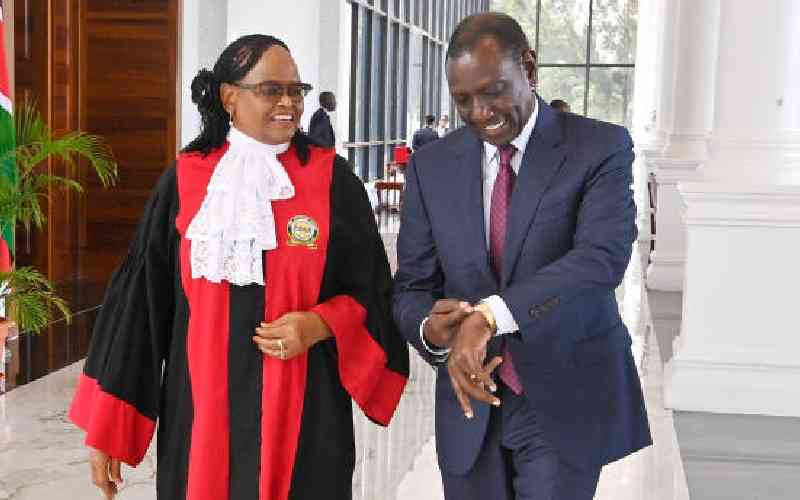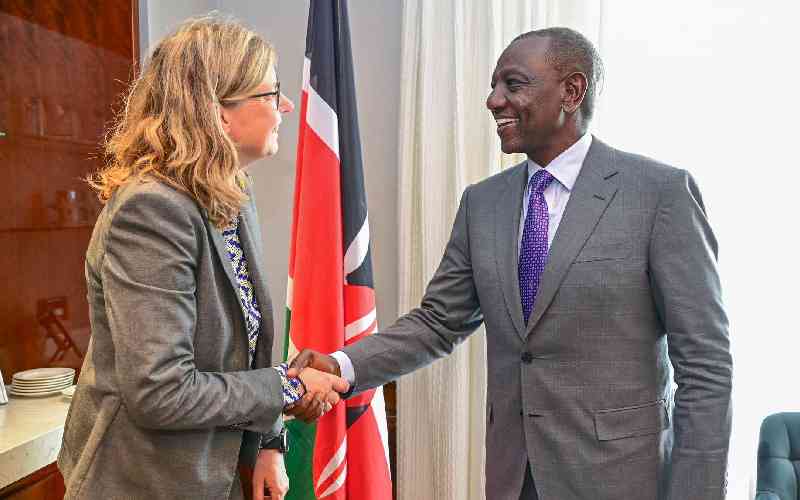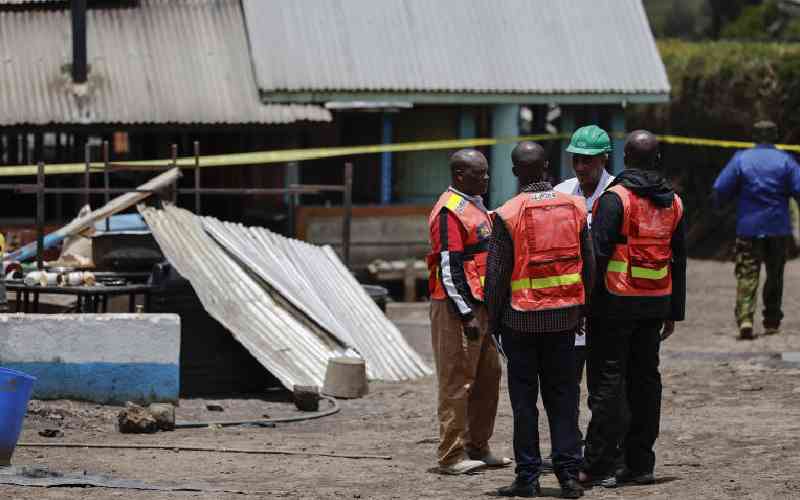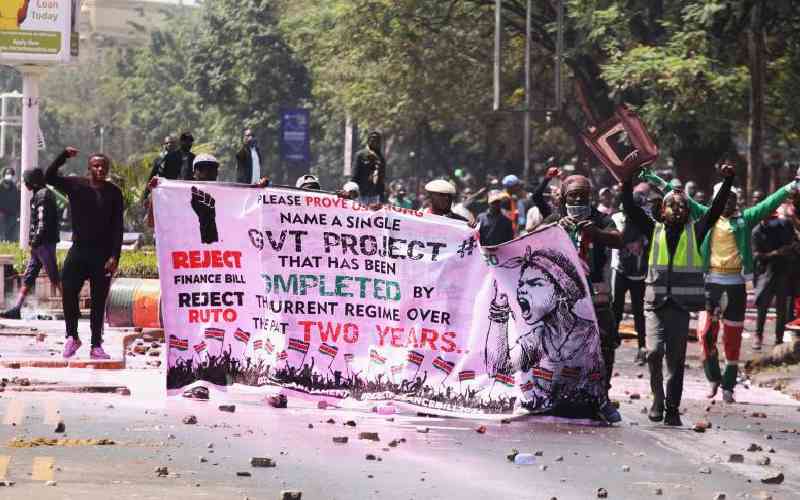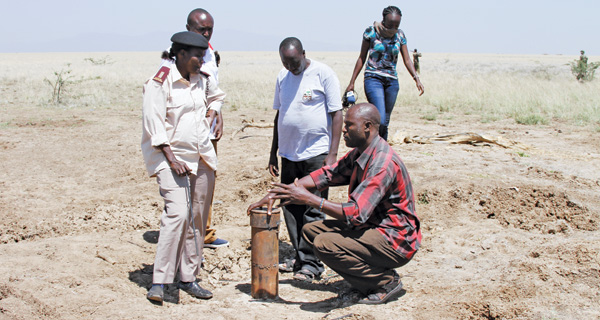 |
|
A water technician William Lokiyoto, shows a sealed water pipe that will be used to supply water in Lotikipi PHOTO: PETER OCHIENG/STANDARD |
By TITUS TOO
Turkana, Kenya: The harsh heat and water scarcity claimed his relative’s life, leaving Nakwasiro Ekope in desperation. For what else could he do in such a dry land?
Ekope recalls how a few years ago, during a long search for water in the expansive Turkana region, his relative fainted.
He has seen the hopelessness of livestock farmers who have lost their wealth due to the soaring temperatures.
“We have no hope. We are just like helpless fish exposed to muddy ground to die due to diminishing water resources,” Ekope, aged about 80, tells The Standard through a translator.
He says for several years now, the pastoral community has been trekking several kilometres in search of water points for domestic use and their livestock.
But in the midst of this despair is a ray of hope that might once and for all redeem this community living in a region where temperatures rise to as high as 37 degrees Centigrade.
Massive underground water reserves were recently discovered in the region and expectations are high among the Turkana people who are also waiting for full exploration of oil also recently found in the area.
A visit by The Standard to the area recently finds upbeat locals who cannot wait for the water to start flowing into their homes to end their misery.
The discovery through research undertaken by the United Nations Educational, Scientific and Cultural Organisation (Unesco) under its Gridmap initiative and conducted by Radar Technologies International with co-ordination by the National Technical and Science Committee, has established the existence of huge underground water reserves in Turkana.
The Lotikipi basin, near Lokichoggio in Turkana West, was found to hold an estimated 207 billion cubic metres of fresh water while another basin in Lodwar (Turkana South) has a 10-billion cubic metres capacity.
And researchers say the discovery could boost the country’s water provision by 8.5 per cent and double the capacity of water for consumption.
At Lotikipi, where drilling was concluded and test bumping done recently, a manyatta is swelling up as residents move closer to the water source.
“I migrated to this manyatta with my relatives and neighbours after we heard of the discovery of water. We appeal to the Government to move with speed and start distributing it,” says Losepisho Longor.
Longor adds that although they are currently just a few metres from the point where the water bumping was done about a week ago, they are still travelling 15km in search of water. The old man says they are demoralised by the delay and says he might be forced to move the family from the manyatta to another destination if the Government delays distribution.
Stay informed. Subscribe to our newsletter
The sight of any visitors to the area arouses more anxiety in the locals who presume that they have come to commission the project.
Along the roads leading to Lotikipi (which means region of plenty water in the Turkana dialect), children and the old line up with containers begging for water from visitors who travel with bottled water.
At the place where the bump testing was done, jubilant children surrounded the cemented point, which has a safely sealed metal outlet, and asked, “Where is the water?”
Amid the whistling sound of strong winds and scorching heat in the semi-arid northern region, the innocent children sing, “God is great, we are thirsty and this will only be our source of livelihood.”
About 20km away, Erot Louren, an elderly widow who does not recall her exact age accompanies her grandchildren to extract water from dried-up sandy waterways as they wait for the Government to start supplying water.
The little water they manage to find is competed for by humans and livestock that include cows, sheep, goats, donkeys and even dogs.
But as the droughts continue, the water points become drier. The nomads are then forced to travel further away.
“It is the first time since the country attained independence that Turkana, perceived to be an arid land is said to have the potential to produce water,” says William Lokiyoto, who works in the technical department of Lokichogio Water Service Providers (LWSP) and also in the Ministry of Water.
He thanked Unesco for the discovery. “Due to high temperatures that occasionally rise to 37 degrees Centigrade, residents are forced to change their lifestyles to minimise the need for already scarce water,” says Lokiyoto.
He adds: “Children and the old in the dry zones minimise walking during the day and also eat in the evenings to minimise thirst”.
Millicent Marrok, the assistant chief in the area that is also in Nanam division of Turkana West, says: “As local leaders, we received news of the discovery of water reserves with joy”.
She says the discovery would minimise conflicts for resources between the neigbouring Turkana and Tobosa communities along the Kenyan and Southern Sudan borders.
“Residents will minimise migration and school enrollment will improve,” says Marrok.
 The Standard Group Plc is a
multi-media organization with investments in media platforms spanning newspaper
print operations, television, radio broadcasting, digital and online services. The
Standard Group is recognized as a leading multi-media house in Kenya with a key
influence in matters of national and international interest.
The Standard Group Plc is a
multi-media organization with investments in media platforms spanning newspaper
print operations, television, radio broadcasting, digital and online services. The
Standard Group is recognized as a leading multi-media house in Kenya with a key
influence in matters of national and international interest.
 The Standard Group Plc is a
multi-media organization with investments in media platforms spanning newspaper
print operations, television, radio broadcasting, digital and online services. The
Standard Group is recognized as a leading multi-media house in Kenya with a key
influence in matters of national and international interest.
The Standard Group Plc is a
multi-media organization with investments in media platforms spanning newspaper
print operations, television, radio broadcasting, digital and online services. The
Standard Group is recognized as a leading multi-media house in Kenya with a key
influence in matters of national and international interest.


